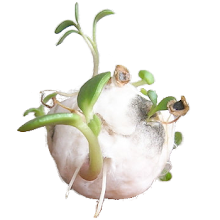There was an interesting article published in the JANUARY/FEBRUARY 2015 edition of The Atlantic, titled, "The Death of the Artist—and the Birth of the Creative Entrepreneur"
You can read the entire article here: http://www.theatlantic.com/magazine/archive/2015/01/the-death-of-the-artist-and-the-birth-of-the-creative-entrepreneur/383497
But I found this part of the article particularly interesting:
The Internet enables you to promote, sell, and deliver directly to the user, and to do so in ways that allow you to compete with corporations and institutions, which previously had a virtual monopoly on marketing and distribution. You can reach potential customers at a speed and on a scale that would have been unthinkable when pretty much the only means were word of mouth, the alternative press, and stapling handbills to telephone poles.
A Gen‑X graphic-artist friend has told me that the young designers she meets are no longer interested in putting in their 10,000 hours. One reason may be that they recognize that 10,000 hours is less important now than 10,000 contacts.
No longer interested in putting in their 10,000 hours: under all three of the old models, an artist was someone who did one thing—who trained intensively in one discipline, one tradition, one set of tools, and who worked to develop one artistic identity. You were a writer, or a painter, or a choreographer. It is hard to think of very many figures who achieved distinction in more than one genre—fiction and poetry, say—let alone in more than one art. Few even attempted the latter (Gertrude Stein admonished Picasso for trying to write poems), and almost never with any success.
But one of the most conspicuous things about today’s young creators is their tendency to construct a multiplicity of artistic identities. You’re a musician and a photographer and a poet; a storyteller and a dancer and a designer—a multiplatform artist, in the term one sometimes sees. Which means that you haven’t got time for your 10,000 hours in any of your chosen media. But technique or expertise is not the point. The point is versatility. Like any good business, you try to diversify.
Works of art, more centrally and nakedly than ever before, are becoming commodities, consumer goods. Jeff Bezos, as a patron, is a very different beast than James Laughlin. Now it’s every man for himself, every tub on its own bottom. Now it’s not an audience you think of addressing; it’s a customer base. Now you’re only as good as your last sales quarter.
It’s hard to believe that the new arrangement will not favor work that’s safer: more familiar, formulaic, user-friendly, eager to please—more like entertainment, less like art. Artists will inevitably spend a lot more time looking over their shoulder, trying to figure out what the customer wants rather than what they themselves are seeking to say. The nature of aesthetic judgment will itself be reconfigured. “No more gatekeepers,” goes the slogan of the Internet apostles. Everyone’s opinion, as expressed in Amazon reviews and suchlike, carries equal weight—the democratization of taste.
It is often said today that the most-successful businesses are those that create experiences rather than products, or create experiences (environments, relationships) around their products. So we might also say that under producerism, in the age of creative entrepreneurship, producing becomes an experience, even the experience. It becomes a lifestyle, something that is packaged as an experience—and an experience, what’s more, after the contemporary fashion: networked, curated, publicized, fetishized, tweeted, catered, and anything but solitary, anything but private.
Among the most notable things about those Web sites that creators now all feel compelled to have is that they tend to present not only the work, not only the creator (which is interesting enough as a cultural fact), but also the creator’s life or lifestyle or process. The customer is being sold, or at least sold on or sold through, a vicarious experience of production.
When works of art become commodities and nothing else, when every endeavor becomes “creative” and everybody “a creative,” then art sinks back to craft and artists back to artisans—a word that, in its adjectival form, at least, is newly popular again. Artisanal pickles, artisanal poems: what’s the difference, after all? So “art” itself may disappear: art as Art, that old high thing. Which—unless, like me, you think we need a vessel for our inner life—is nothing much to mourn.


No comments:
Post a Comment